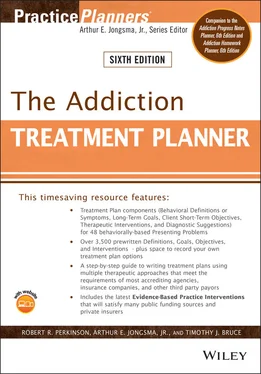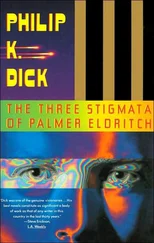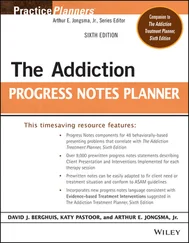The Addiction Treatment Planner
Здесь есть возможность читать онлайн «The Addiction Treatment Planner» — ознакомительный отрывок электронной книги совершенно бесплатно, а после прочтения отрывка купить полную версию. В некоторых случаях можно слушать аудио, скачать через торрент в формате fb2 и присутствует краткое содержание. Жанр: unrecognised, на английском языке. Описание произведения, (предисловие) а так же отзывы посетителей доступны на портале библиотеки ЛибКат.
- Название:The Addiction Treatment Planner
- Автор:
- Жанр:
- Год:неизвестен
- ISBN:нет данных
- Рейтинг книги:4 / 5. Голосов: 1
-
Избранное:Добавить в избранное
- Отзывы:
-
Ваша оценка:
- 80
- 1
- 2
- 3
- 4
- 5
The Addiction Treatment Planner: краткое содержание, описание и аннотация
Предлагаем к чтению аннотацию, описание, краткое содержание или предисловие (зависит от того, что написал сам автор книги «The Addiction Treatment Planner»). Если вы не нашли необходимую информацию о книге — напишите в комментариях, мы постараемся отыскать её.
The Addiction Treatment Planner, Sixth Edition
The Additction Treatment Planner, Sixth Edition
The Addiction Treatment Planner — читать онлайн ознакомительный отрывок
Ниже представлен текст книги, разбитый по страницам. Система сохранения места последней прочитанной страницы, позволяет с удобством читать онлайн бесплатно книгу «The Addiction Treatment Planner», без необходимости каждый раз заново искать на чём Вы остановились. Поставьте закладку, и сможете в любой момент перейти на страницу, на которой закончили чтение.
Интервал:
Закладка:
More recently, psychotherapy research is moving toward trying to identify evidence-based principles of psychotherapeutic change that cut across the various individual psychotherapies that have largely been the focus of outcome research. An example of this call in seen in Goldfried (2019), in which he advances the following principles:
Promoting client expectation and motivation that therapy can help,
Establishing an optimal therapeutic alliance,
Facilitating client awareness of the factors associated with his or her difficulties,
Encouraging the client to engage in corrective experiences, and
Emphasizing ongoing reality testing in the client's life.
Although many endorse this effort, at the time of this writing it is still in progress. Consequently, our approach to identifying objectives and interventions consistent with EBPs reflects what has been done from the “principles” approach as well as the research demonstrating the efficacy and effectiveness of individual models. Perhaps the field will advance enough by the next edition of this planner to include only evidence-based principles of psychotherapeutic change. Until then, we believe that the approach we have taken reflects the current state of the science.
We would also like to note that for those selecting EBT objectives and interventions in their treatment, fidelity to the EBT as it was delivered in the studies demonstrating its efficacy or effectiveness offers the best chance for reproducing its results for your client. A demonstration of this point was witnessed in a recently published meta-analysis examining 12-Step Facilitation Therapy (TSF; Kelly, Humphreys, & Kelly, 2020). The review found that TSF manualized interventions intended to increase Alcoholics Anonymous (AA) participation during and following alcohol use disorder (AUD) treatment lead to enhanced abstinence outcomes compared to other well-established treatments over the next few months and for up to three years. Of note was that fidelity to the TSF treatment model was critical to this outcome as conveyed in this statement by the authors:
…when different types of TSF interventions were tested against each other, the more intensive TSF interventions (e.g. those that include actively prescribing AA participation and ongoing monitoring of AA attendance and related experiences; personal linkages to existing AA members) often worked better at improving drinking-related outcomes than the ‘“treatment as usual (TAU) TSF”’ intervention. This suggests that although many treatment professionals may believe that they “‘already do 12-step’” (i.e. implement TSF strategies) because they hand out 12-step literature or mention 12-step groups to patients, this alone may not be sufficient to achieve a superior benefit (Kelly, Humphreys, & Yeterian, 2013). The types of TSF strategies used do matter, and the more intensive strategies, such as those evaluated herein, enhance participation rates and outcomes compared to the more routine 12-step-oriented TAU. Some of these strategies could be clinical linkage to existing members (e.g. Manning, et al. 2012; Timko, Debenedetti, & Billow, 2006), or active prescription of attendance versus leaving it to people to decide for themselves whether they want to attend AA (e.g. Walitzer, Dermen, & Barrick, 2009) (p. 33).
Throughout this Planner we cite references and include an appendix of clinical resources, including treatment manuals and books, which describe the how-to of delivering the EBT with high fidelity, and we recommend them for those who share the value of delivering treatment with the intent to maximize the client's outcome.
At the beginning of each chapter, as we launch into the process of offering ideas for treatment interventions for the presenting problem, we have listed one Client Objective along with two associated Therapeutic Interventions that emphasize the critical nature of a therapeutic relationship. These options were derived from the research on empirically supported relationship factors (e.g. Norcross, 2002) and disseminated most recently in Norcross & Lambert (2018) and Norcoross & Wampold (2018). The relationship factors cited are as follows: collaboration with the client regarding the treatment process, agreement on the clear goals and expectations of therapy, demonstration of consistent empathy toward the client's feelings and struggles, verbalization of positive regard toward and affirmation of the client, and the collection and delivery of client feedback based on the client's appraisal of his/her progress in therapy (Norcross & Lambert, 2018; Norcross & Wampold, 2018). The body of research on relationship factors supports the conclusion that establishing a strong therapeutic relationship is necessary to optimize the treatment outcome. Accordingly, any of the other objectives and interventions that are selected to be included in a client's treatment plan should be integrated into and supported by an effective, foundational therapeutic relationship, and speaks to including this Client Objective and two associated Therapeutic Interventions in every treatment plan.
Each of the chapters in this edition has also been reviewed with the goal of integrating homework exercise options into the interventions. Many of the client homework exercise suggestions were taken from and can be found in the Addiction Treatment Homework Planner (Lenz, Finley, & Jongsma, 2014) and the Adult Psychotherapy Homework Planner (Jongsma & Bruce, 2014) along with a few from the Adolescent Psychotherapy Homework Planner (2014). You will find many more homework assignments suggested in this sixth edition of The Addiction Treatment Planner than in previous editions.
The bibliotherapy suggestions listed in Appendix Aof this Planner have been significantly expanded and updated from previous editions. The appendix includes many recently published offerings as well as more recent editions of books cited in our earlier editions. All of the self-help books and client workbooks cited in the chapter interventions are listed in this appendix. There are also many additional books listed that are supportive of the treatment approaches described in the respective chapters. Each chapter has a list of self-help books consistent with it listed in this appendix.
In its final report entitled Achieving the Promise: Transforming Mental Health Care in America , the president's New Freedom Commission on Mental Health called for recovery to be the “common, recognized outcome of mental health services” (New Freedom Commission on Mental Health, 2003). To define recovery, SAMHSA within the US Department of Health and Human Services and the Interagency Committee on Disability Research in partnership with six other federal agencies convened the National Consensus Conference on Mental Health Recovery and Mental Health Systems Transformation (SAMHSA, 2004). Over 110 expert panelists participated, including mental health consumers, family members, providers, advocates, researchers, academicians, managed care representatives, accreditation bodies, state and local public officials, and others. From these deliberations, the following consensus statement was derived:
Mental health recovery is a journey of healing and transformation for a person with a mental health problem to be able to live a meaningful life in a community of his or her choice while striving to achieve maximum human potential. Recovery is a multifaceted concept based on the following 10 fundamental elements and guiding principles:
Self-direction
Individualized and person-centered
Empowerment
Holistic
Nonlinear
Strengths-based
Peer support
Respect
Responsibility
Hope
These recovery model principles are defined in Appendix C. We have also created a set of Goal, Objective, and Intervention statements that reflect these 10 principles. The clinician who desires to insert into the client treatment plan specific statements reflecting a Recovery Model orientation may choose from this list.
Читать дальшеИнтервал:
Закладка:
Похожие книги на «The Addiction Treatment Planner»
Представляем Вашему вниманию похожие книги на «The Addiction Treatment Planner» списком для выбора. Мы отобрали схожую по названию и смыслу литературу в надежде предоставить читателям больше вариантов отыскать новые, интересные, ещё непрочитанные произведения.
Обсуждение, отзывы о книге «The Addiction Treatment Planner» и просто собственные мнения читателей. Оставьте ваши комментарии, напишите, что Вы думаете о произведении, его смысле или главных героях. Укажите что конкретно понравилось, а что нет, и почему Вы так считаете.












